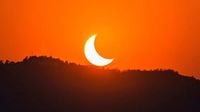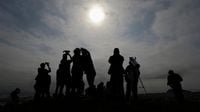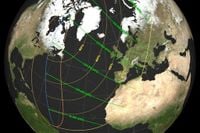On March 29, 2025, a partial solar eclipse will grace the skies over a vast expanse, visible from the United States, Canada, Greenland, Europe, Africa, and parts of Russia. This celestial event marks the first solar eclipse of the year and the second in the 2025 eclipse season, providing a unique opportunity for millions to witness a beautiful phenomenon.
The eclipse will commence at 08:50 GMT and conclude at 12:43 GMT, with the peak occurring at 10:47 GMT, when approximately 93.7% of the Sun will be obscured. This event stands out not just for its visibility across multiple continents, but also for the timing, allowing many to observe it during the morning hours.
In North America, the best views will be in the northeastern regions. For instance, Nuuk, Greenland, will experience the maximum eclipse at 08:53 local time, with a magnitude of 0.892 and 87.41% obscuration. Halifax, Canada, will see its peak at 07:17, with an impressive 83% of the Sun covered. Other notable cities include St. John's, which will reach its maximum at 07:52, experiencing 82.56% obscuration.
For those in the United States, particularly in Maine, the eclipse will be visible at sunrise. Presque Isle will witness the event at 06:21, with 85.40% obscuration, while cities like Boston and New York will see lesser obscuration at 42.91% and 21.83%, respectively. This unique opportunity to see the Sun partially eclipsed at dawn is a rare treat for early risers.
Across the Atlantic, Europe enjoys a more favorable viewing schedule. Reykjavik, Iceland, will experience the eclipse at 11:05 with a magnitude of 0.736, while Dublin, Ireland, will peak at 11:00 with 41.28% obscuration. London and Paris will also have good views, with obscurations of 30.62% and 23.51%, respectively. The timing allows for a significant portion of the population to witness this astronomical event.
In northwestern Africa, the eclipse will also be visible, albeit with slightly lower obscuration percentages. Cities in Morocco, such as El Yadida and Casablanca, will experience 18.12% and 17.29% obscuration, respectively. This partial solar eclipse promises a captivating sight for those within its path.
To prepare for viewing, enthusiasts are advised to use proper eye protection. NASA emphasizes that one should never look directly at the Sun without certified eclipse glasses (ISO 12312-2) or solar filters for telescopes and cameras. Without these precautions, serious eye damage can occur. For those without eclipse glasses, indirect viewing methods such as pinhole projectors or tree shadows can provide safe alternatives.
The excitement surrounding this eclipse is heightened by its accessibility. Unlike total solar eclipses, which are visible only along a narrow path, this partial eclipse will be seen by a broad audience across several continents. The event is expected to attract both seasoned astronomers and casual observers alike, eager to experience the wonder of the cosmos.
What makes this eclipse particularly special is the combination of its wide visibility and the unique timing. Many observers will witness the Sun rising partially eclipsed, creating an enchanting visual effect. This phenomenon, while not as dramatic as a total eclipse, still offers a stunning sight that captures the imagination.
Looking ahead, the next solar eclipse after March 29 will occur on September 21, 2025, and will also be a partial eclipse, primarily visible in New Zealand and Antarctica. However, the anticipation for the total solar eclipses in 2026 and 2027 is already building, as these events will offer even more spectacular views.
In summary, the partial solar eclipse on March 29, 2025, promises to be a memorable event for skywatchers across the globe. With careful planning, proper eye protection, and the right timing, millions will have the chance to witness this celestial spectacle. Mark your calendars and prepare to look up; the universe has a show for you!









